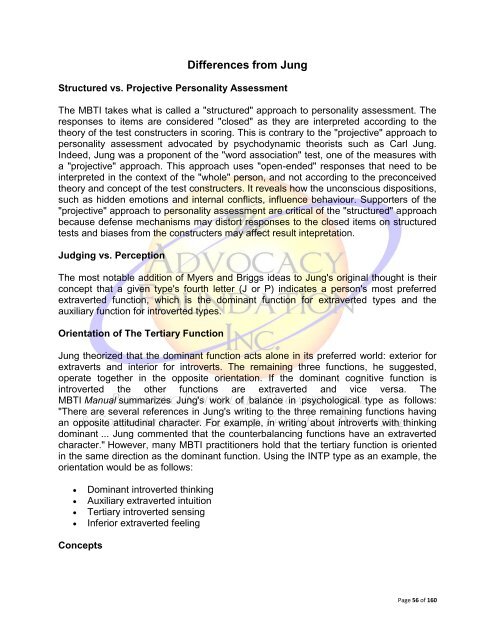The Gift of Introversion
The Gift of Introversion
The Gift of Introversion
Create successful ePaper yourself
Turn your PDF publications into a flip-book with our unique Google optimized e-Paper software.
Differences from Jung<br />
Structured vs. Projective Personality Assessment<br />
<strong>The</strong> MBTI takes what is called a "structured" approach to personality assessment. <strong>The</strong><br />
responses to items are considered "closed" as they are interpreted according to the<br />
theory <strong>of</strong> the test constructers in scoring. This is contrary to the "projective" approach to<br />
personality assessment advocated by psychodynamic theorists such as Carl Jung.<br />
Indeed, Jung was a proponent <strong>of</strong> the "word association" test, one <strong>of</strong> the measures with<br />
a "projective" approach. This approach uses "open-ended" responses that need to be<br />
interpreted in the context <strong>of</strong> the "whole" person, and not according to the preconceived<br />
theory and concept <strong>of</strong> the test constructers. It reveals how the unconscious dispositions,<br />
such as hidden emotions and internal conflicts, influence behaviour. Supporters <strong>of</strong> the<br />
"projective" approach to personality assessment are critical <strong>of</strong> the "structured" approach<br />
because defense mechanisms may distort responses to the closed items on structured<br />
tests and biases from the constructers may affect result intepretation.<br />
Judging vs. Perception<br />
<strong>The</strong> most notable addition <strong>of</strong> Myers and Briggs ideas to Jung's original thought is their<br />
concept that a given type's fourth letter (J or P) indicates a person's most preferred<br />
extraverted function, which is the dominant function for extraverted types and the<br />
auxiliary function for introverted types.<br />
Orientation <strong>of</strong> <strong>The</strong> Tertiary Function<br />
Jung theorized that the dominant function acts alone in its preferred world: exterior for<br />
extraverts and interior for introverts. <strong>The</strong> remaining three functions, he suggested,<br />
operate together in the opposite orientation. If the dominant cognitive function is<br />
introverted the other functions are extraverted and vice versa. <strong>The</strong><br />
MBTI Manual summarizes Jung's work <strong>of</strong> balance in psychological type as follows:<br />
"<strong>The</strong>re are several references in Jung's writing to the three remaining functions having<br />
an opposite attitudinal character. For example, in writing about introverts with thinking<br />
dominant ... Jung commented that the counterbalancing functions have an extraverted<br />
character." However, many MBTI practitioners hold that the tertiary function is oriented<br />
in the same direction as the dominant function. Using the INTP type as an example, the<br />
orientation would be as follows:<br />
<br />
<br />
<br />
<br />
Dominant introverted thinking<br />
Auxiliary extraverted intuition<br />
Tertiary introverted sensing<br />
Inferior extraverted feeling<br />
Concepts<br />
Page 56 <strong>of</strong> 160

















